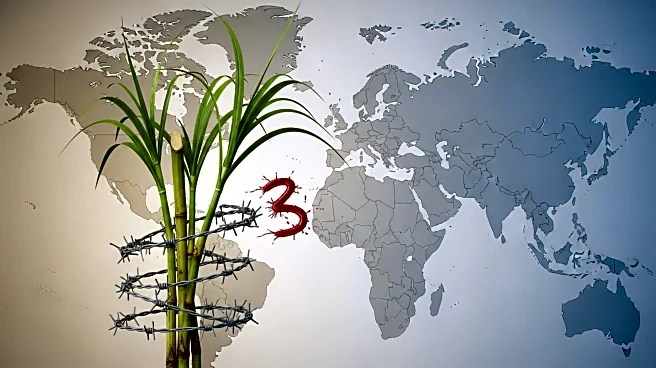What is the story about?
What's Happening?
China has effectively halted its purchases of U.S. soybeans, marking a significant shift in global agricultural trade. This decision is rooted in ongoing trade tensions and China's strategic objectives for food security. As of October 2, 2025, the cessation of buying has severely impacted U.S. soybean farmers, leading to plummeting prices and a surplus of unsold crops. This move has also solidified the dominance of South American suppliers in the global soybean market. The absence of China, historically the largest buyer of U.S. soybeans, has caused U.S. soybean futures prices to drop significantly, with new crop November 2025 futures falling over $0.51 per bushel in a short period. This situation poses significant economic challenges for American farmers, who are now facing inventory and storage issues.
Why It's Important?
The halt in U.S. soybean purchases by China represents a major realignment in global agricultural supply chains. This shift challenges the historical dominance of the U.S. in the soybean market and highlights the risks of over-reliance on a single major buyer. The economic strain on U.S. agriculture is substantial, with potential long-term changes in farming practices and economic viability. South American countries, particularly Brazil, have benefited from increased Chinese demand, further solidifying their market position. This development underscores the geopolitical dynamics influencing global trade and the strategic use of agricultural commodities as leverage in international relations.
What's Next?
In the short term, U.S. soybean exports to China are expected to remain low, with prohibitive tariffs continuing to depress prices. The U.S. government may provide financial aid to support farmers, but this is seen as a temporary measure. South American suppliers are likely to maintain their dominance in meeting China's soybean demand. Upcoming trade talks between the U.S. and China, including a planned meeting between President Trump and President Xi Jinping, may influence market sentiment, but analysts are cautious about the potential for a significant shift in trade dynamics. In the long term, the global soybean trade landscape is likely to be permanently reshaped, with China continuing to diversify its sourcing and reduce reliance on U.S. soybeans.
Beyond the Headlines
China's strategic pivot away from U.S. soybeans is part of a broader effort to diversify its agricultural sourcing and enhance food security. This move is not just a market disturbance but a reflection of long-term geopolitical strategies. The U.S. agricultural sector faces immense pressure to adapt, potentially leading to shifts in crop cultivation and export strategies. The situation also highlights the role of agricultural commodities in geopolitical maneuvering, with potential implications for other sectors and commodities.
AI Generated Content
Do you find this article useful?















